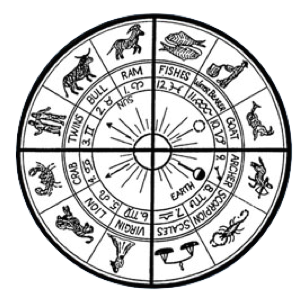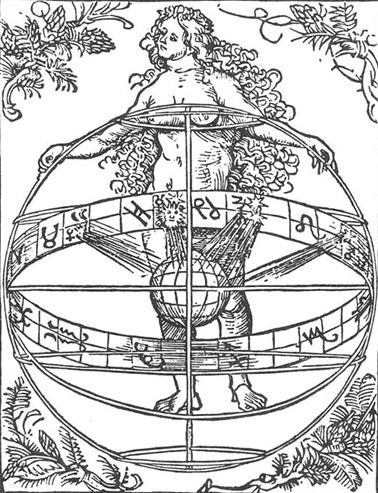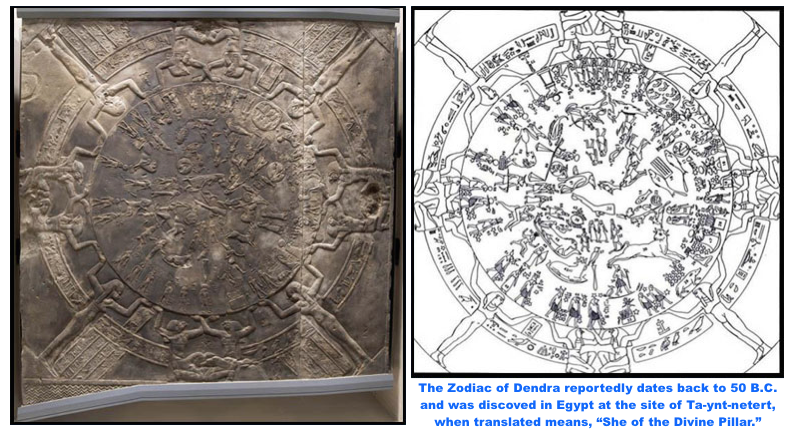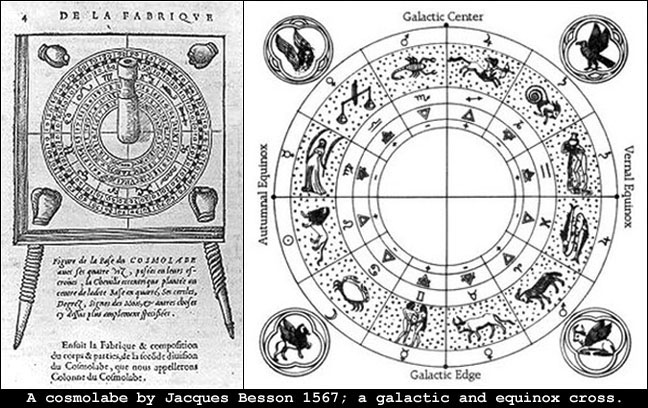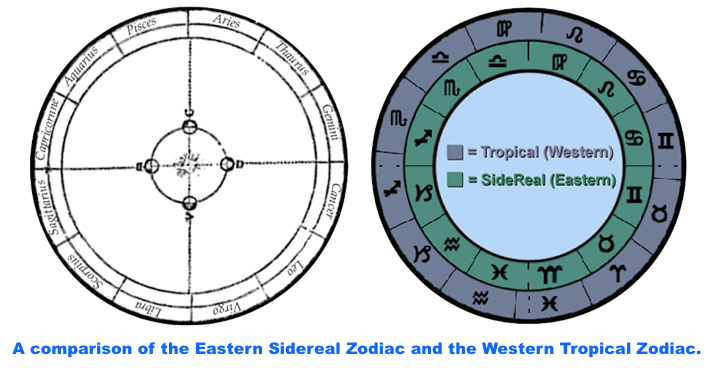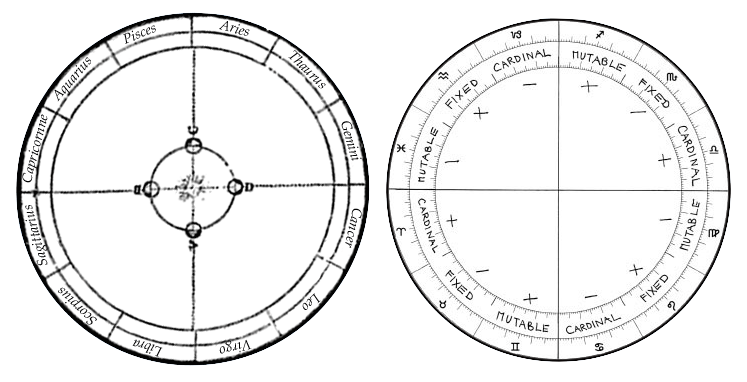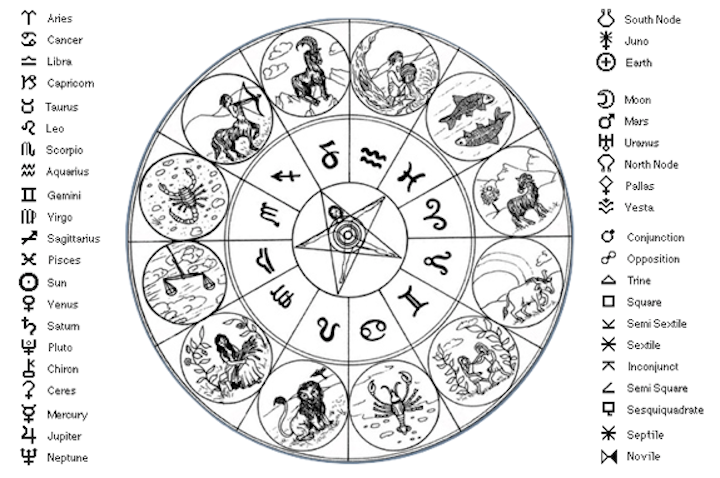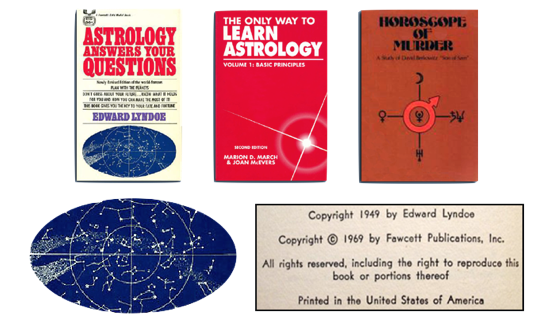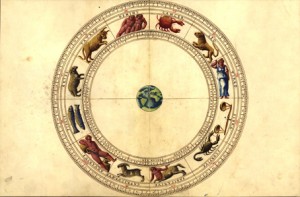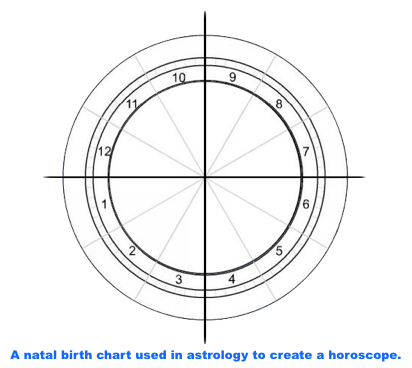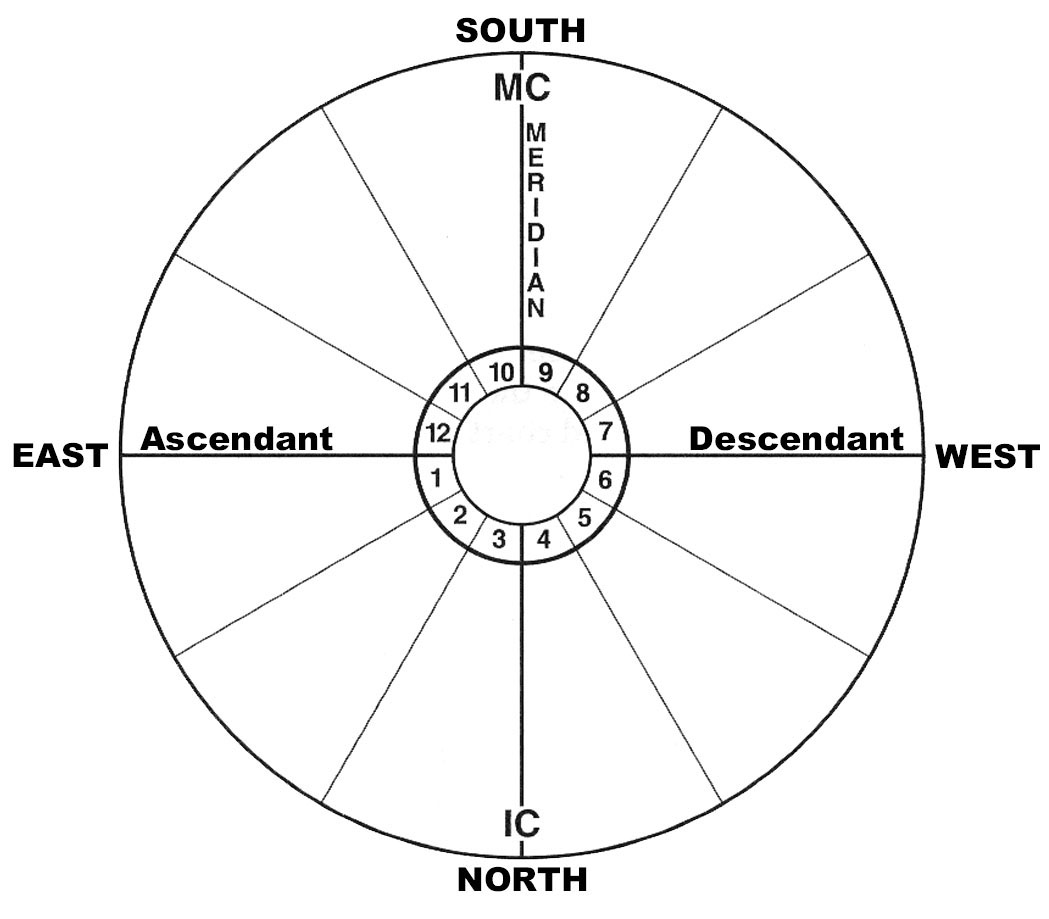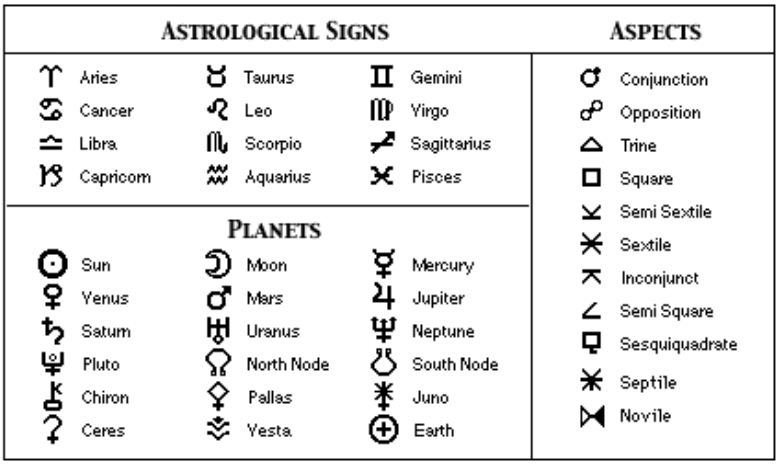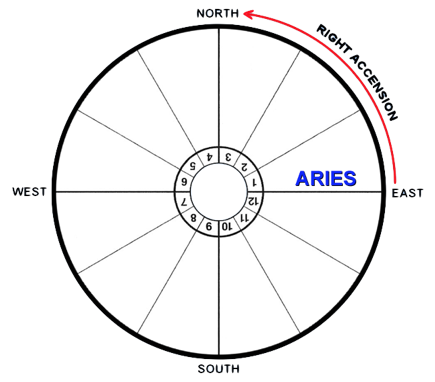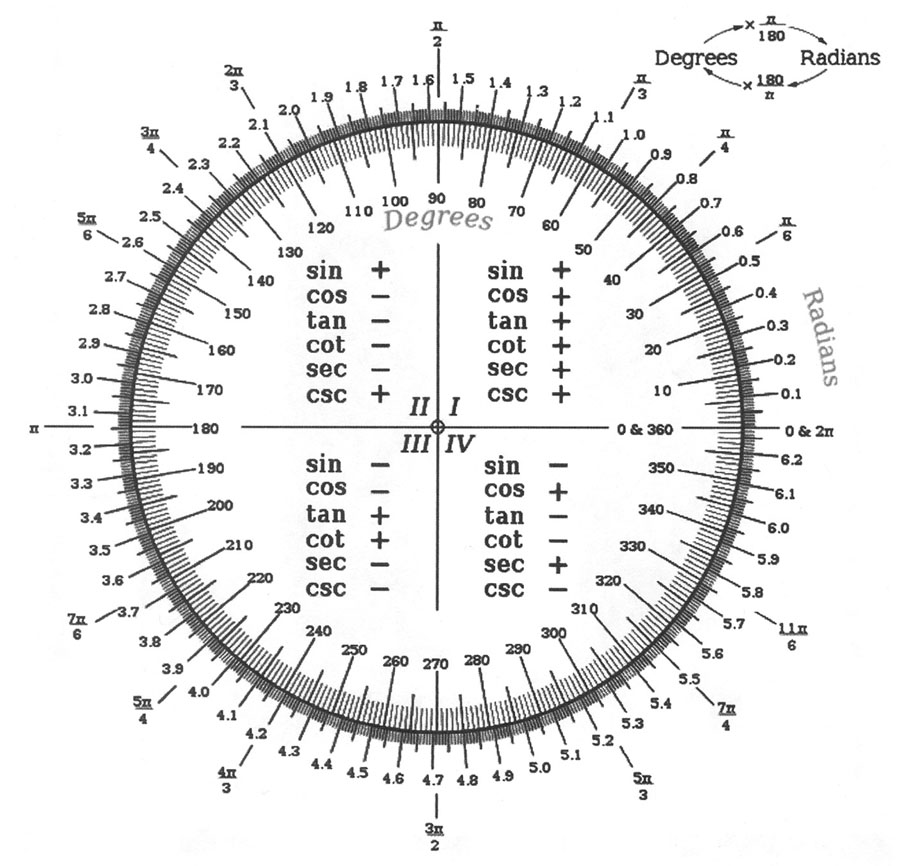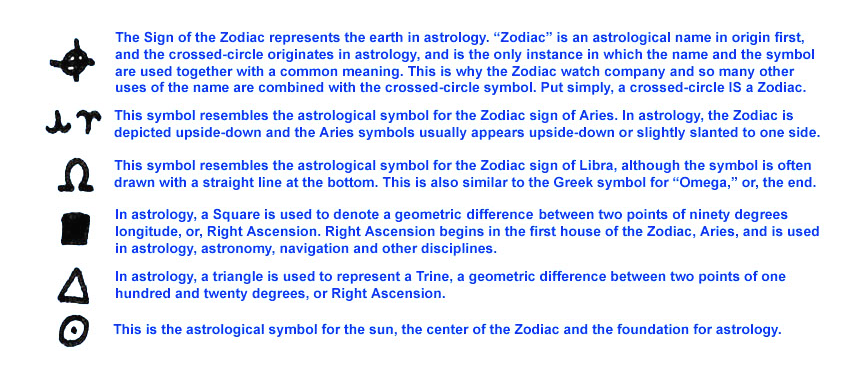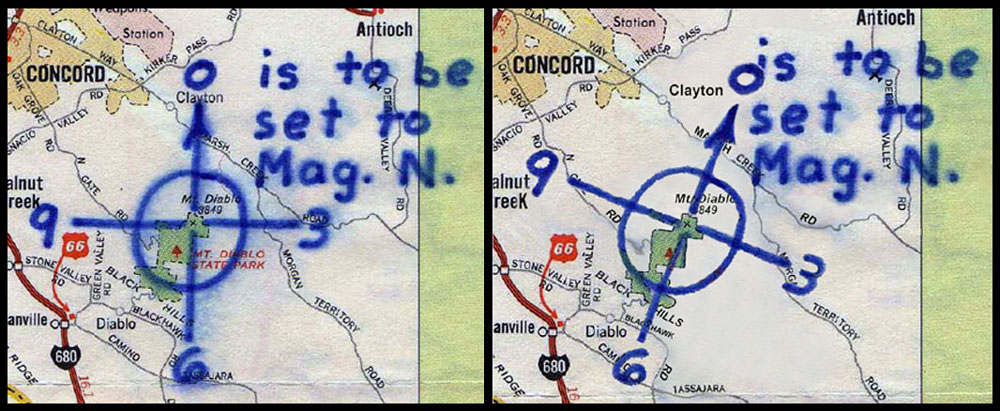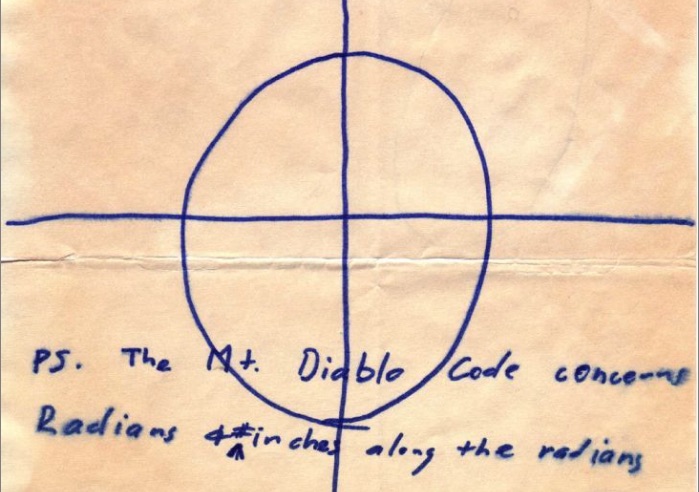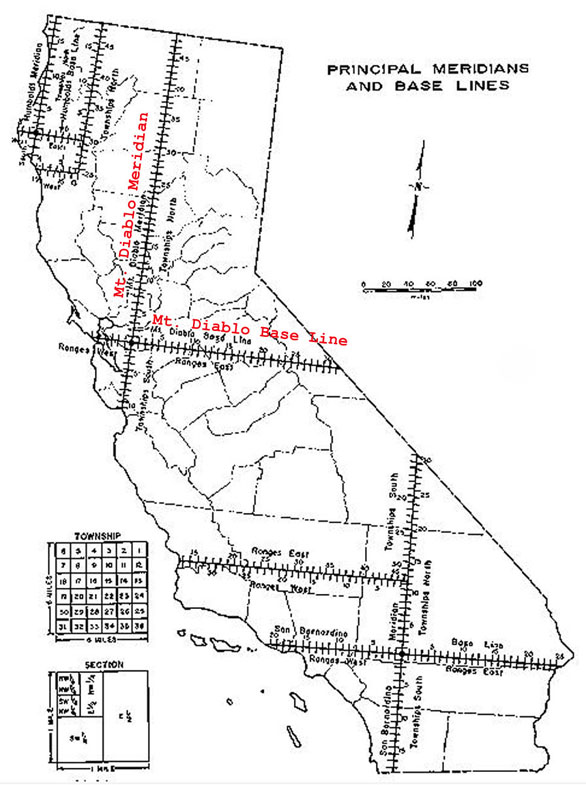The first and most common pairing of the name “Zodiac” and the crossed circle symbol has its origins in astrology and dates back centuries. In astrology, the name and symbol are used together, and this is the only use of the pairing in which the two are linked by a common meaning. The name “Zodiac” is derived from the Greek word “zodiakos,” which, translated, means “a circle of animals.” The American Heritage Dictionary (1983) offers the following definitions:
zodiac : n. 1.a. A band of the celestial sphere, extending about eight degrees to either side of the ecliptic (the sun’s path), that represents the path of the principal planets, the moon and the sun. b. In astrology, this band divided into 12 equal parts called signs, each 30 degrees wide, bearing the name of a constellation for which it was originally named. 2. A diagram or figure representing the zodiac.
Webster’s New Collegiate Dictionary (1949) adds other definitions of interest: 2. Rare – a circuit; zone; also, a girdle. Zodiacal light: A nebulous light seen in the West after twilight and in the East before dawn. The 1991 English translation of J. E. Cirlot’s 1971 A Dictionary of Symbols states that the word ‘zodiac’ is derived from the words zoe (life) and diakos (wheel).
The astrological Zodiac has existed for centuries. According to some estimates, the first Zodiac appeared sometime during the 7th century (BC), when Babylonian astronomers first discerned the rotation of the planets and constellations along the zodiac circle, the path of the sun known as the “eliptic.” The first known “zodiac” in circular form was discovered in Egypt at the ancient site of Ta-ynt-netert (or ‘She of the Divine Pillar’). Known as the Zodiac of Dendera, this ancient illustration dated as far back as 50 B.C., and contained what would become the fixed elements of the astrological Zodiac– the circle and the cross. [Learn more about the history of astrology by visiting the website sacred-texts.com.]
The book An ABC of Witchcraft Past & Present (1973) by Doreen Valiente further described the astrological zodiac and its origins. The author also explained a common source of confusion in astrology:
“The basic premise of astrology is contained in the famous sentence from the Emerald Tablet of Hermes Trismegistus: ‘Quod est inferius est sicut quod est superius, et quod est superius est sicut quod est inferius, ad perpetranda rei unius.’ (‘That which is below is like unto that which is above, and that which is above is like unto that which is below, for the performing of the miracles of the One Thing.’)… There are really two zodiacs, the zodiac of the constellations which can be seen in the night sky, and the zodiac which is the plane of the ecliptic. The former is called the Sidereal Zodiac, and the latter the Tropical Zodiac. Astrologers of India and the East generally, still use the Sidereal Zodiac; but those of the West mostly use the Tropical Zodiac. The latter is the apparent path of the sun in the year, as it appears to circle the earth. Like any other circle, this has 360 degrees… The Tropical Zodiac commences at the spring Equinox, when the sun appears to enter the sign of Aries, the Ram, and day and night are equal. Valiente adds that “there is a story that in very far-off days the zodiac was reckoned to consist, not of twelve signs of 30 degrees each, but of ten signs of 36 degrees each; the Libra sign being omitted, and the signs Virgo and Scorpio being reckoned as one. This, says an obscure occult legend, referred to the time when the human race was androgynous, having both sexes in one.”
In January 2011, astronomer Parke Kunkle stated that the earth and the sun were constantly moving and that the changes in the earth’s alignment inevitably caused changes in the astrological Zodiac. Media reports quickly announced that the Zodiac had changed and therefore changed the astrological signs of everyone on the planet. The news caused a frenzy of confusion and criticism until Kunkle and others accurately noted, “This is not new news… Astronomers have known about this since about 130 B.C.” Media reports then stated that the confusion was caused by the differences between Eastern and Western versions of astrology. The sidereal Zodiac used in Eastern astrology originally included a thirteen sign Ophiuchus the snake holder but this sign was eventually discarded by the Ancient Babylonians who preferred a Zodiac with 12 houses. The Zodiac was also adapted and changed by many cultures and societies over the centuries.
The website Dimension1111.com provided this explanation of the two Zodiacs: “There are two systems of astrology that are in use today. Tropical astrology and Sidereal astrology. Tropical astrology is considered the traditional style and is mostly used in the western part of the world. This system uses the tropical zodiac. This is the method that is mostly explained in this astrological tutorial. Alternatively, in the eastern part of the world the sidereal zodiac, and this system is known as sidereal astrology. In Sidereal astrology, the zodiac is measured according to the “actual” constellations, or grouping of stars, as we observe them today. Because the earth slowly shifts position over time (the precession of the equinoxes), the actual star groups known as the constellations slowly shift their positions in relation to us as well. Sidereal Astrology is based then on the theory that the dates of the Sun’s entrance into each sign should change along with the earth’s shift in position.”
The website LunarPlanner.com features an informative article titled The Tropical and Sidereal Zodiaks & The Cycle of Earth’s Precessional Cross which includes an animated illustration of the astrological Zodiac and the crossed-circle.
In astrology, the crossed-circle symbol is used to represent the Zodiac, and is therefore called a Zodiac. Astrologers use this symbol in all aspects of astrology and, in order create a natal chart or “read” a horoscope, one must begin by drawing a crossed-circle, or, a Zodiac. The name Zodiac did not appear in the first letters mailed by the notorious killer. In his first three letters of July 1969, the author referred to himself as “the murderer,” however, he did draw a crossed-circle at the end of each letter. By signing the letters only with a crossed circle, the author had, in fact, used the symbol that literally meant “The Zodiac.”
Even the San Francisco Police Department had discovered this simple connection in the first weeks of the their investigation. In late 1969, Captain Martin Lee told reporters that investigators had consulted astrologers regarding the Zodiac’s name and symbols. “We have made two or three inquiries of people in that business to gain information on what particular signs might mean. In fact, it was just a day or so ago that we learned that little symbol of the circle with the cross in the center of it, uh, what they told us is that this symbolizes the center of the universe, and this is called ‘The Sign of the Zodiac.’” [Watch the video of Captain Lee’s press conference.]
Some skeptics have argued that the name “Zodiac” does not usually appear with the crossed-circle symbol in astrology, however, the name AND the symbol are synonymous and have the same meaning. In astrology, the name Zodiac rarely appears with the crossed-circle symbol precisely because a crossed-circle symbol represents the name “Zodiac.” The Zodiac killer never used the name and the symbol together; in fact, in his first letters, the killer did not use the name Zodiac at all. Instead, the killer signed these messages with a crossed-circle symbol, proving that the name and symbol were interchangable and had the same meaning to him as well. Some skeptics also argue that they have not seen the crossed-circle symbol used to represent the astrological Zodiac, however, the crossed-circle symbol has been used in this fashion for centuries (as demonstrated by the many illustrations provided here). The 1969 edition of the book Astrology Answers Your Questions featured a crossed-circle symbol on the cover, as did the cover of the 1997 book The Only Way To Learn Astrology. The crossed circle also appeared on the cover of a book about the horoscope as it related to confessed serial killer David Berkowitz aka Son of Sam.
Time and place are essential to the astrological Zodiac, and play an important part in the astrologer’s interpretations. The birthplace of the subject is determined by longitude and latitude, and this information is examined along with the time and date of birth as well. The Zodiac also depicts the seasons, the compass directions and the planetary positions. The word “horoscope” means “hour pointer,” or “map of the hour,” and comes from the Greek word “horoskopos,” or “hour watcher.”
Astrology uses the crossed-circle to denote the four seasons, the four points on a compass, and the earth. However, the crossed-circle also serves as the basis for all astrological analysis. The natural or flat wheel is a chart from which the astrologer is said to “read” the horoscope of a chosen individual. In order to accurately interpret the chart, the astrologer must have the date, time and place of the subject’s birth. This information is then interpreted using various methods, and applied to the chart of the zodiac. The resulting horoscope is defined as a map or diagram of the heavens erected to determine the potentials, characteristics, or future of a the person in question.
The chart, or wheel, is constructed in stages. First, a circle is drawn. Then, the circle– representing the earth– is divided by what are called meridian and horizon lines. The horizontal axis of the chart is called the equator, or horizon, which divides the chart into day and night sections, designating day planets and night planets. The vertical axis, or meridian, divides the chart into an eastern half and a western half. These two sections are formed when the chart is divided along the noon to midnight axis. With this division, an astrologer can identify rising planets, which are those in the eastern half of the chart in the time from midnight to noon, and setting planets, in the western half of the chart in the time from noon to midnight. This division is referred to as dividing the houses by quality. The meridian and horizon lines also correspond to the cusp of each sign which represent the four Cardinal points of a compass. These are called Cardinal signs because they govern the change of season: ARIES = East, Spring / CANCER= North, Summer / LIBRA = West, Fall / CAPRICORN = South, Winter.
When the wheel chart is divided by the seasons or direction, the circle is effectively divided into four equal parts of 90 degrees each, or, a crossed-circle, and is often depicted as such.
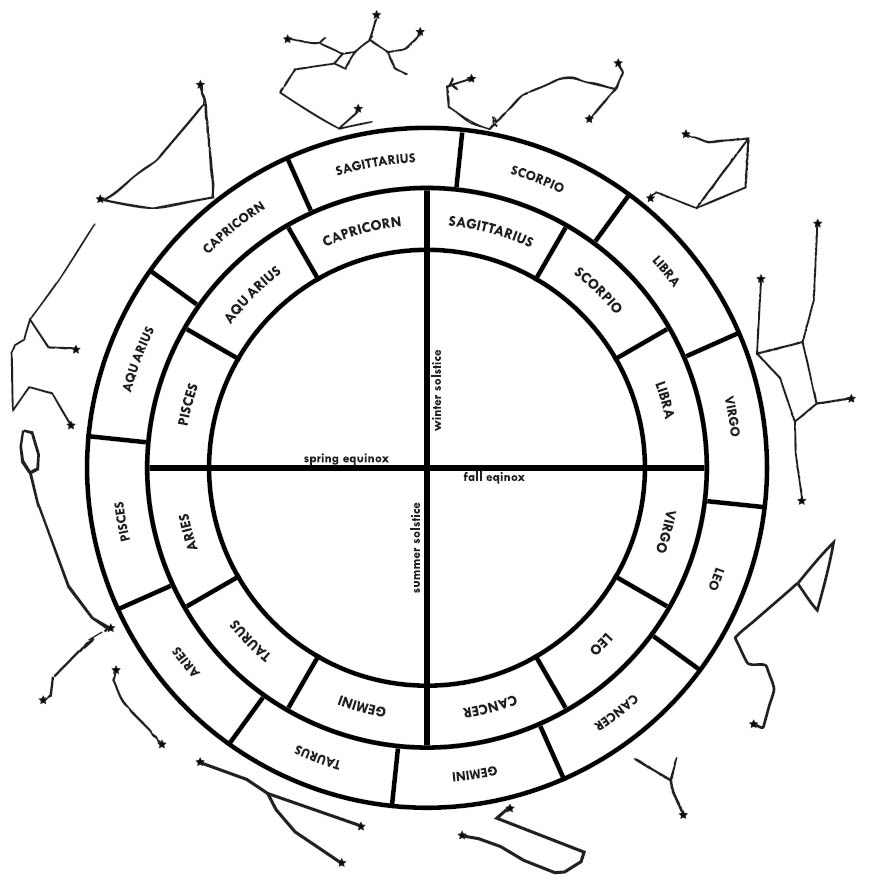
The first house of the zodiac is Aries, the rising or Ascendant sign. The border line between the end of the twelfth house of Pisces and this first house is called the first house cusp. As the starting point of the Zodiac, this point, or cusp, is designated at zero degrees. The sign of Aries spans thirty degrees, and is measured from zero to twenty-nine degrees. The remaining eleven signs are similarly measured from the end of the first house onward, counterclockwise.
The planets play a key part in the construction and reading of a natural or flat wheel chart (used to provide a horoscope) and are represented by various symbols. The planets commonly used in astrology are the Moon, the Sun, Mercury, Venus, Mars, Jupiter, Saturn, Uranus, Neptune, Pluto and the Earth. Planets are said to be in aspect to each other when they are separated by a specific number of degrees away from one another. The distances between these planets can be determined by using a table of what are called major aspects. This table varies according to the methods and purposes of the astrologer, but common among these aspects are conjunction, sextile, square, trine, opposition and quincunx (or inconjunct). Each aspect spans a number of degrees in addition to the corresponding number of signs, and is represented by an astrological symbol. A Square (also called a Quadrature) is represented by a square, and indicates a difference of ninety degrees longitude, or, right ascension. A Trine is represented by a triangle, and indicates a difference of one hundred and twenty degrees, or, right ascension. A definition of Right Ascension was provided by the website scienceworld.wolfram.com
RIGHT ASCENSION: The azimuthal angle at which the hour circle of a celestial object is located. The rotation axis taken as the direction of the celestial pole. Right ascension is usually measured in units of time (hours, minutes, and seconds), with one hour of time approximately equal to 15° of arc (360°/24 hours=15°/hour). Because the time for the Earth to complete a rotation relative to the “fixed” stars is slightly shorter than the time to complete a rotation relative to the Sun (a sidereal day is 23 h 56 m 4.1 s, whereas a solar day is 24 hours), one hour of right ascension is actually equal to 360°/23.9344…hours= /h.
Right ascension is standard method used in navigations, physics, astrology, astronomy, and other disciplines. The explanation below was provided by the website The Astrophysics Spectator.
Positions on the sky are measured in terms of right ascension (RA or α) and declination (dec. or δ). These correspond to longitude and latitude on Earth. The declination is measured in degrees relative to the celestial equator, which is the projection of Earth’s equator onto the sky. The declination of the equator is 0°, the declination of the north pole is 90°, and the declination of the south pole is −90°. The right ascension is defined in units of time, with 0 hour at the first point of Aries, and the value of the right ascension at the zenith increasing as time passes. A full circle of the equator corresponds to 24 hours. Right ascension was defined to make finding objects with a telescope easier: the right ascension at the zenith changes by one hour in one hour of sidereal time.
Geometric angles play a key role in the practice of astrology. When constructing a horoscope for an individual, an astrologer will determine the alignment of the planets as seen from the earth at the time and place of birth. Then, the astrologer will measure the differences between these “aspects” using geometric angles. In astrology, specific symbols are used to represent various angles. The following information comes from the website FindYourFate.com:
Aspect is the geometric relationship between two planets in the horoscope chart. Aspects are important in analyzing a horoscope because they give the combined effect of the functions of the two planets involved. The major aspects between the planets are the conjunction, semi-sextile, sextile, square, trine, square, Quincuncx and opposition. The semi-sextile, sextile, trine and conjunction are said to be good or favorable whereas the square, opposition and quincunx are taken to be not favorable.Aspects are the vital factors in the formation of ones character.
The Conjunction – The conjunction is formed when two planets are at approximately the same degree of the same sign or at an orb of not more than 8 degrees. In a conjunction, the energies of the two planets are combined, and the result is often a strengthening of both. Connjuction of Lords of 1, 4, 7 and 10th houses produces good effects. Conjunction of the trine Lords (5th and 9th houses) are always good irrespective of their location. A Moon-Venus conjunction is beneficial whereas a Saturn- Mars conjunction is said to be stressful.
The Semi-Sextile – This aspect is formed when two planets are 30 degrees apart with an orb of two degrees in either direction. This aspect is reckoned to be mildly favorable with the planets working well together.
The Sextile – Sextiles occur when two planets are approximately 60 degrees apart. This is the aspect of opportunity. It is the 3rd and the 11th house Hindu aspect. Initiatives can be taken during this aspect and it reinforces the weak points in life. It is a very beign aspect indicative of talent, confidence and popularity.
The Square – Squares occur when two planets are approximately 90 degrees apart. It is the 4th and the 10th house Hindu aspect. Square causes the friction and the hurdles that help us to grow and become productive. This is the most critical amd conflicting aspect. It gives disturbed, prejudiced or adverse conditions and circumstances accompanying it. It is a separative aspect and it turns the tide of fortune.
The Trine – A trine occurs when two planets are approximately 120 degrees apart. It is the 5th and the 9th house Hindu aspect. Trines bring about ease and comfort.This is a fortunate aspect for harmony, peace and does much to improve adverse aspects. When occuring between Sun and Moon it is more fortunate than any other aspect.
The Opposition – The opposition occurs when two planets are about 180 degrees apart. It is the 7th house Hindu aspect. As the name implies, opposition are obstacles that must be resolved. This is a malefic aspect of perfect balance. It includes confrontation and partnership. It indicates change of circumstances. Oppositions can manifest as mood swings.
Similar to aspects are nodes, which designate either of the two points where the orbit of a planets intersects the ecliptic, or where the orbit of a satellite intersects the plane of the orbit of its primary. The node passed as the body goes north is called the ascending node, and that passed going south, the descending node. These ascending and descending nodes are also referred to, respectively, as The Dragon’s Head and The Dragon’s Tail.
The various symbols for the planets, their relationships, angles and signs are then applied to the flat wheel in order to read a horoscope. The astrologer uses the symbols to construct a formula which often resembles a mathematical equation.
In summary, the astrological flat or natural wheel has the following characteristics and elements 1) the name “the Zodiac” 2) the crossed circle, which serves several purposes: a) a compass designating North, East, West and South b) a horizontal axis, or equator/horizon line, dividing the wheel into day and night sections, and, a vertical axis, or meridian line, which divides the wheel into Easter and Western halves. These are used to determine the times of planetary position c) a cross designating the four Cardinal points of a compass and the four seasons 4) angles measured by degrees 5) symbols representing these angles, as well as the planets, and the signs of the Zodiac.
The Zodiac mailed a Halloween card with featured his own additions and illustrations, using the words “SLAVES” and “PARADICE” to form a cross. In each of the four quadrants, the Zodiac added the phrases, “BY FIRE, BY GUN, BY KNIFE” and “BY ROPE.” The meaning of the Zodiac’s message remains unknown but it is possible that he was alluding to the four elements of the astrological Zodiac. The Zodiac also wrote the phrase “sorry no cipher” in the form of a cross as if to reinforce his intended interpretation. Even the stamp depicted a view of the earth from the moon as further confirmation.
The Zodiac claimed that his infamous “Mt. Diablo” map and code would help authorities locate a bomb, and the killer suggested that the use of radians and inches would assist in the search.
A radian is an angle used in mathematics, valued at 57.3 degrees. A radian is defined as: “The radian is a unit of angular measure defined such that an angle of one radian subtended from the center of a unit circle produces an arc with arc length 1.” (Source: Weisstein, Eric W. “Radian.”From MathWorld–A Wolfram Web Resource.) A radian is a geometric angle, meaning that anyone who attempted to decipher the Zodiac’s code and apply that solution to the map in question would be required to use geometric angles to find the location allegedly specified by the Zodiac.
Radians are not simply measured in whole units; any number of degrees can be converted to radians. For example, 38 degrees is equal to 0.663225 radians, 79 degrees is equal to 1.37881, and 165 degrees is equal to 2.87979 radians. The Zodiac’s instructions specifically referred to “radians,” indicating that the solution to his “Mt. Diablo code” required radians, meaning, more than one radian, or, any number of degrees measured in radians.
The Zodiac’s Mt. Diablo code featured several symbols which are used in astrology. The code contained one symbol which resembled the astrological symbol for the sign of Aries, although the Zodiac’s symbol is upside-down.
In most illustrations, the astrological Zodiac is depicted as seen from space. When the astrological Zodiac is depicted as seen from the perspective of the earth, the house of Aries moves and the symbol often appears upside-down in such illustrations.
Other symbols found in the Zodiac’s code are used in astrology to denote geometric angles and to identify a specific location.
The Zodiac’s code was purportedly intended to assist in identifying a specific location. The killer provided a map which featured a crossed-circle symbol on the peak of Mt. Diablo. The cross was placed over the mountain in such a manner that the four points approximated the four points of a compass, and, at each of these positions, the Zodiac had written a number; North = 0, East = 3, South = 6, and West = 9. To the right of the zero were the following words: “is to be set to Mag. N.” This was an obvious reference to Magnetic North, defined as the direction to which the north-seeking pole of a magnetic compass needle points. Magnetic north is defined by the Merriam-Webster Dictionary as “the northerly direction in the earth’s magnetic field indicated by the north-seeking pole of a compass needle.” The magnetic force of the earth pulls the compass needle out of alignment with true north. The difference between true north and magnetic north is the angle of declination, which varies according to the location of a compass on the earth. The angle of declination from Mt. Diablo at the time the Zodiac sent his map was estimated between 16.5 and 17 degrees east of true North. The declination is occasionally adjusted as the magnetic force of the earth that causes the variation shifts and changes with the passage of time.
In another letter, the Zodiac included his largest crossed-circle, which covered more than half of a page. Below this, the Zodiac had written “PS. The Mt. Diablo code concerns Radians & # inches along the radians.”
Zodiac provided all the necessary tools if he was actually attempting to give authorities the material required to locate a specific geographic location. The map, the Magnetic North annotation, and the instructions regarding radians and inches are all appropriate for the Zodiac’s stated task, and the use of Mt. Diablo as a geographic marker and starting point suggests that the Zodiac knew exactly what he was doing.
According to the website of the Mt. Diablo Surveyors Historical Society, “Mount Diablo is the starting point for the establishment of land boundaries throughout most of Northern California and all of Nevada. The summit is the location of the ‘Initial Point,’ the north/south meridian, and east/west baseline intersection point that is the basis for most property boundaries.”
The Zodiac’s Mt. Diablo code, map and hints appeared to reference geometric angles, radians and inches, and more in order to identify a specific location. The killer’s code contained symbols used in astrology to denote geometric angles, the sign of Aries, and the sun. The key components of the astrological Zodiac are the crossed-circle, the name Zodiac, geometric angles, the sun, and the use of Right Ascension which begins at the house of Aries in order to identify a specific location. The available evidence indicates that the self-described “Zodiac” may have been inspired by the astrological “Zodiac” when choosing his adopted name and symbol.


